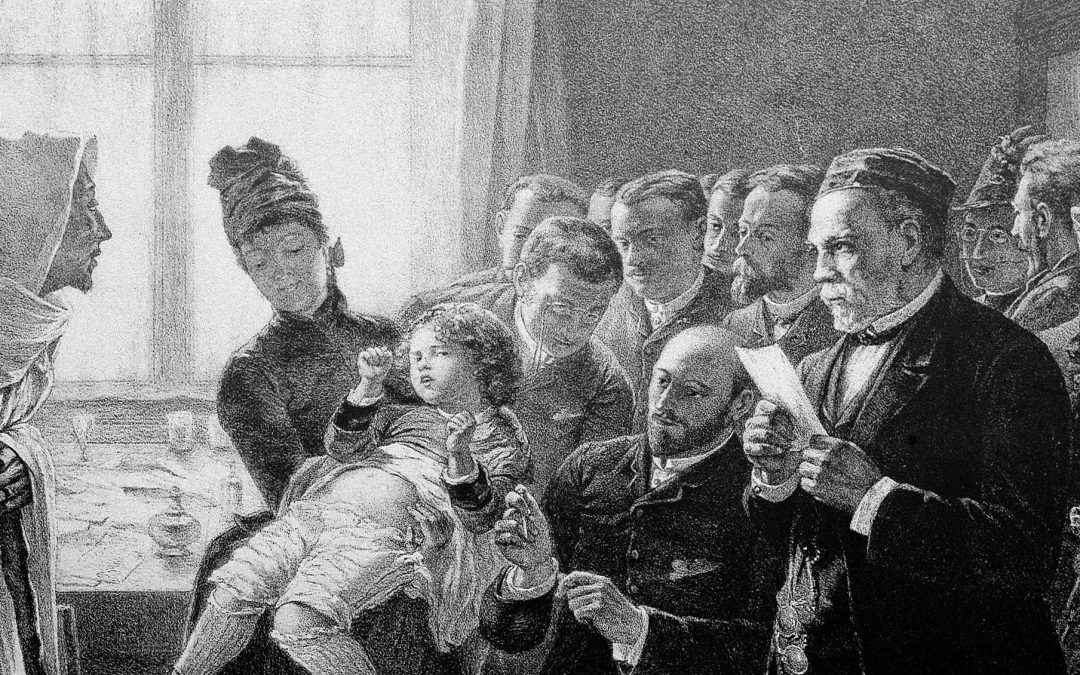—In the second half of the nineteenth century, the bacteriological laboratory was transformed into a new setting for diagnosing, preventing and treating infectious diseases.—
The verification that microscopic living things were the origin of infectious diseases was carried out in the laboratory. It provided diagnostic confirmation of the first hypotheses formulated in this regard. The consolidation of medical microbiology occurred in the last quarter of the nineteenth century and was coupled with the emergence of immunology, an area dedicated to the study of the body’s defensive mechanisms against infection. In these developments, the studies carried out by Louis Pasteur’s microbiological laboratories in France and Robert Koch’s in Germany were decisive. In both cases it was essential to mobilise notions and techniques from chemistry, a scientific discipline fully crystallised in previous decades.
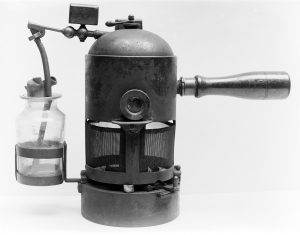
Lister carbolic acid vaporiser. Wellcome Library.
Louis Pasteur (1822-1895) came from a modest Catholic family dedicated to leather tanning. He trained in experimental sciences until he obtained a degree in science to be appointed professor of chemistry at the University of Strasbourg. From this initial training on he addressed the study of fermentation, particularly that which produced the transformation of wine into vinegar. He verified that it occurred when a specific yeast in the air, a microorganism, settled on the wine. He observed that the same phenomenon occurred when souring beer or milk, although caused by other specific yeasts, different from the one above. Without the presence of these microbes, fermentation did not occur and, therefore, it was not an exclusively chemical process as had been argued until then. The use of the microscope made it possible to identify the different yeasts. These findings provided solutions for the food industry such as the ‘pasteurisation’ of milk and other foods, especially beverages. The aim was to subject them to temperatures below 100°C in order to eliminate heat-sensitive microorganisms. Surgical antisepsis was the result of the medical application of this discovery and contributed to the consolidation of medical microbiology. After reading Pasteur’s studies, the British surgeon Joseph Lister (1827-1912) attributed gas gangrene, which often occurred in both accidental and surgical wounds, to microorganisms existing in the air surrounding the patient, and which then settled on the wound. The use of disinfectants such as phenolic acid (phenol) made it possible to control this serious medical complication, which frequently forced amputations or caused the death of the patient.
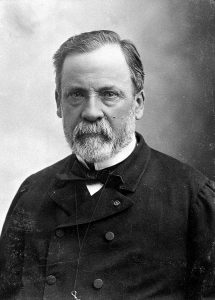
Louis Pasteur (1822-1895). Wellcome Library.
The possibility that ferments, similar to those studied by Pasteur, could appear spontaneously in the air was accepted by a good number of authors in the central decades of the nineteenth century. Pasteur prepared a whole series of experiments to refute this theory of ‘spontaneous generation’. He used swan neck flasks, in which he placed a vegetable infusion, introduced air with germs inside, boiled the infusion to sterilise it and verified that it remained free of germs, assuming that the neck of the flask kept them out. As additional evidence, Pasteur showed that when the neck was broken contamination was immediate, which seemed to confirm the role of air in the appearance of microorganisms. These experiments were questioned by Félix-Archimède Pouchet (1800-1872) in one of the most studied controversies in the history of science, which will be discussed in another section.

Robert Koch (1843-1910). Wellcome Library.
The theory of the germs that Pasteur applied to fermentation was reused to interpret diseases, because he was convinced that these were analogous processes. His first decisive incursion into this terrain was through the study of anthrax in 1877. He confirmed Koch’s hypothesis, the discoverer of Bacillus anthracis, as to the transmission of the disease to animals through food. He thus interpreted the high mortality rate of animals due to anthrax in certain grazing areas known as ‘cursed fields’ which were simply places of burial for anthrax animals. Pasteur claimed that anthrax spores, carried to the surface by earthworms, settled on the ground. Any wound that an animal may have sustained by eating thorny plants mixed with alfalfa could serve as an entrance for the bacill.
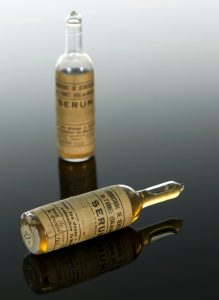
Serum ampoules in the Science Museum, London. Wellcome Library.
In 1881 he developed an anti-anthrax vaccine which he tested in his famous experiments at Pouilly-le-Fort. On a farm in this town and before an expectant crowd, he vaccinated 31 animals with which he subsequently inoculated the anthrax bacteria, as well as 29 other unvaccinated animals. He was able to satisfactorily show that the first group survived, while the unvaccinated died of the disease. After this success, Pasteur insisted that the vaccine should be prepared in his laboratory in order to control its use. He combined ‘official’ communication of the results of his scientific work with direct information for those affected by the agricultural and livestock problems studied in his laboratory. Proof of this is the lecture he gave on the above mentioned farm to the audience gathered to witness the anthrax vaccination. He clearly explained the studies he had carried out on the disease and their prophylaxis.
Pasteur extended the vaccination technique to some human diseases, first of all, rabies. Due to the impossibility of cultivating the pathogen in vitro as it is a virus, he chose to cultivate it in living organisms and managed to transmit the disease by directly injecting the brain matter of a rabid dog, into the surface of the brain of a healthy animal, previously having undergone trepanation. After obtaining rabies viruses of varying degrees of virulence by successively putting them through different animal species, he made a series of dogs resistant to rabies by inoculations of cultures of progressively increasing virulence. In 1885 he first applied the vaccine to Joseph Meister, a 9-year-old boy who arrived at Pasteur’s laboratory two days after being bitten by a rabid dog. In the manufacture of this vaccine, he had used a method of in vitro attenuation of the virus, consisting of using rabbit marrow containing viruses with a fixed inoculation period of seven days. The desiccation of this marrow attenuated the virus. Protection against the disease was achieved by progressively inoculating with ever fresher marrow. Gradually the centres that provided this treatment spread all over the world. In France, the Academy of Sciences agreed to create an anti-rabies centre called the Pasteur Institute.
The German bacteriological school was led by Robert Koch (1843-1910). In 1873 he began his research in microbiology in the field of public health by addressing the problem of anthrax, which decimated the livestock in the region and which was sometimes transmitted to humans, and managed to clarify the mechanism of contagion from the anthrax infected animal to humans. In 1880 he was put at the head of a bacteriological research laboratory where pure microorganism culture techniques were developed in solid and semi-solid mediums, which was more specific than the liquid mediums used by Pasteur, and sterilisation and disinfection techniques were developed. Koch defined the characteristics that a microorganism must display to be identified as the cause of a specific infection in a patient (known as Koch postulates): it must always be found in all individuals who present symptoms of the disease; this must be isolated in a pure culture; when this pure culture is inoculated into an experimental animal it must cause the disease; the causative microorganism must be isolated again in this experimental animal and be identified in a pure culture.
His laboratory also identified the tubercle bacillus, known as Koch’s bacillus, in 1882 and the cholera bacillus in 1884, during a trip to Egypt and India, in which he demonstrated its transmission mechanism. Koch erred in thinking that tuberculin, a protein derivative he obtained from the tubercle bacillus, could be a healing substance. However, it became a diagnostic test by detecting antibodies of the disease when injected. It is known as the Mantoux test. The detection of antibodies, proteins produced by the body’s immune system when it detects foreign substances, especially microorganisms, became a fundamental laboratory diagnostic test in the identification of the infectious disease in patients. The knowledge of antibodies in turn led to serotherapy, a therapeutic method that consists of administering serum containing the specific antibodies against the microorganism causing the infection from which the patient suffers.
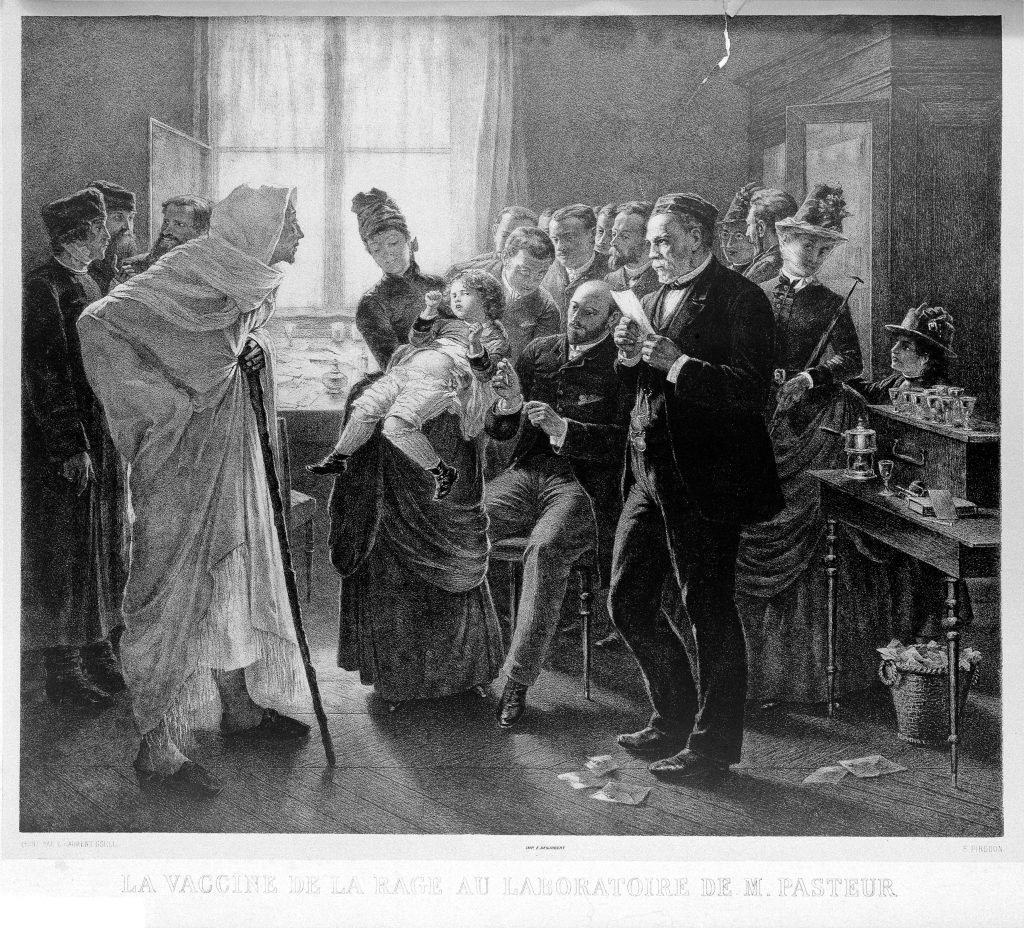
Rabies vaccine in Louis Pasteur’s laboratory. Lithograph by Gsell and Pirodon. Wellcome Library.
The identification of the microbial etiology of tuberculosis and cholera led to the establishment of a Hygiene Institute at the University of Berlin, which had a bacteriology laboratory. Koch began working there in 1885 as a hygiene teacher and trained a group of students who made up the core of the German microbiology school. Soon Koch moved to the newly created Institute of Infectious Diseases, which he directed between 1891 and 1904, in whose laboratories tetanus and diphtheria antitoxins were developed. In the last years of his life, he made several trips to Africa to study tropical diseases such as malaria and sleeping sickness. His research earned him the Nobel Prize in Physiology or Medicine in 1905. He died five years later.
Mª José Báguena Cervellera
IILP-UV
How to cite this paper:
Báguena Cervellera, Mª José. Bacteria and laboratories. Sabers en acció, 2021-01-15. https://sabersenaccio.iec.cat/en/bacteria-and-laboratories/.
Find out more
You can find further information with the bibliography and available resources.
Recommended reading
Brock, Thomas D. Robert Koch, a life in medicine and bacteriology. Oxford: Science Tech Publishers; 1988.
Debra, Patrice. Louis Pasteur. Baltimore: The Johns Hopkins University Press; 2000.
Studies
Báguena, María José. La tuberculosis y su historia. Barcelona: Uriach; 1992.
Rosen, George. A History of Public Health. Revised, expanded edition. Baltimore: Johns Hopkins University Press; 2015.
Vikhanski, Luba. Immunity. Chicago: Chicago Review Press Inc.; 2016.
Sources
Carter, Kay C. Essays of Robert Koch. Westport: Greenwood Publishing Group; 1987.
Louis Pasteur. Antología. Selección y prólogo de María José Báguena. Barcelona: Círculo de Lectores; 1996.
Websites and other resources
American Society of Microbiology. Center for the History of Microbiology/ASM Archives (CHOMA) [Updated 2020; accessed 3 Jul 2020]. Available here.

